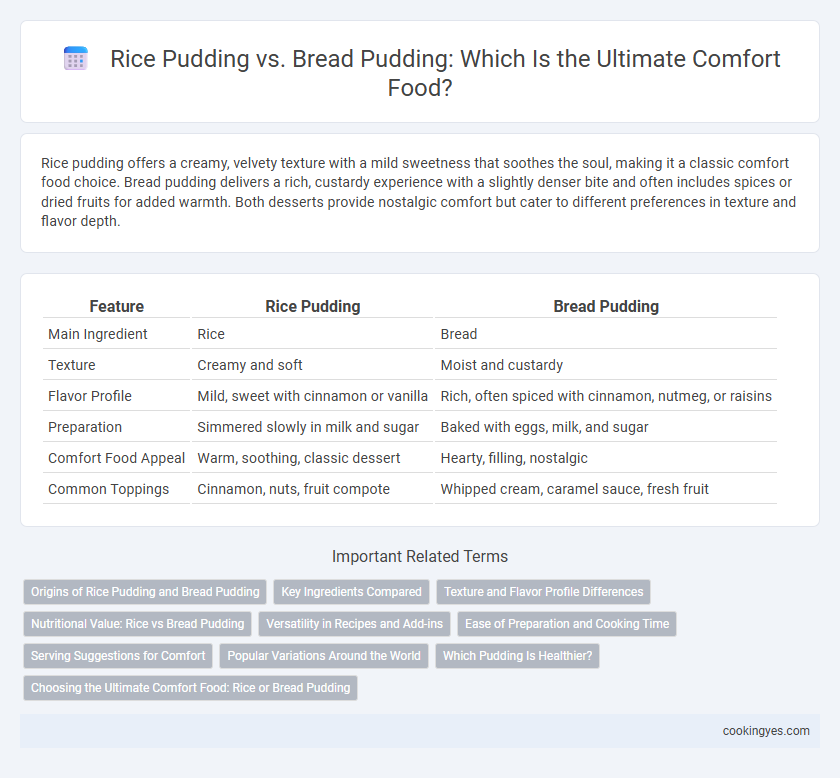Rice pudding offers a creamy, velvety texture with a mild sweetness that soothes the soul, making it a classic comfort food choice. Bread pudding delivers a rich, custardy experience with a slightly denser bite and often includes spices or dried fruits for added warmth. Both desserts provide nostalgic comfort but cater to different preferences in texture and flavor depth.
Table of Comparison
| Feature | Rice Pudding | Bread Pudding |
|---|---|---|
| Main Ingredient | Rice | Bread |
| Texture | Creamy and soft | Moist and custardy |
| Flavor Profile | Mild, sweet with cinnamon or vanilla | Rich, often spiced with cinnamon, nutmeg, or raisins |
| Preparation | Simmered slowly in milk and sugar | Baked with eggs, milk, and sugar |
| Comfort Food Appeal | Warm, soothing, classic dessert | Hearty, filling, nostalgic |
| Common Toppings | Cinnamon, nuts, fruit compote | Whipped cream, caramel sauce, fresh fruit |
Origins of Rice Pudding and Bread Pudding
Rice pudding traces its origins to ancient Asia and the Middle East, where it was traditionally made by cooking rice with milk, sugar, and spices, symbolizing comfort and sustenance. Bread pudding emerged from medieval Europe as a practical way to use stale bread combined with eggs, milk, and sweeteners, evolving into a beloved comfort food dessert. Both dishes reflect regional agricultural staples and cultural adaptations, highlighting their enduring roles as comforting and resourceful homemade treats.
Key Ingredients Compared
Rice pudding is made primarily with cooked rice, milk or cream, sugar, and spices like cinnamon or nutmeg, creating a creamy and smooth texture that offers a subtle sweetness. Bread pudding uses stale bread soaked in a custard mixture of milk, eggs, sugar, and often vanilla or cinnamon, resulting in a denser, cake-like consistency with a richer flavor profile. Both desserts rely on dairy and sweeteners, but the starch base--rice versus bread--significantly influences texture and mouthfeel, shaping their unique comfort food appeal.
Texture and Flavor Profile Differences
Rice pudding offers a creamy, smooth texture with tender, slightly chewy rice grains that create a soothing mouthfeel, while its flavor blends sweet vanilla and warm cinnamon notes. Bread pudding, on the other hand, provides a denser, custard-soaked texture with crisp edges and a rich buttery flavor enhanced by spices like nutmeg and cloves. Both desserts deliver comforting sweetness, but the contrast lies in rice pudding's silky comfort versus bread pudding's hearty, cake-like satisfaction.
Nutritional Value: Rice vs Bread Pudding
Rice pudding offers a lighter option with lower fat content and is generally easier to digest compared to bread pudding, which tends to have higher calories and fat due to butter and eggs. Rice pudding provides more carbohydrates from the rice, supporting quick energy release, while bread pudding contains more protein originating from the bread and dairy ingredients. Both desserts can be tailored for nutritional balance, but rice pudding typically suits those seeking a gentler, lower-calorie comfort food.
Versatility in Recipes and Add-ins
Rice pudding offers versatility with its ability to incorporate a wide range of flavors such as cinnamon, cardamom, raisins, and coconut milk, making it adaptable to both sweet and mildly savory variations. Bread pudding stands out for its capacity to absorb rich custards and accommodate diverse add-ins like chocolate chips, nuts, fruits, and spices, lending itself well to decadent and comforting desserts. Both puddings provide customizable options that can easily be tailored to individual tastes and dietary preferences, enhancing their role as beloved comfort foods.
Ease of Preparation and Cooking Time
Rice pudding offers a simple preparation process, requiring only rice, milk, sugar, and a few spices, with a typical cooking time of about 30-45 minutes. Bread pudding uses day-old bread soaked in a custard mixture, and it generally takes 45-60 minutes to bake, making it slightly longer to prepare. Both provide comforting textures and flavors, but rice pudding is often preferred for quicker, hassle-free cooking.
Serving Suggestions for Comfort
Rice pudding offers a creamy texture that pairs well with a sprinkle of cinnamon or a drizzle of honey, making it a soothing comfort food. Bread pudding's custard-soaked cubes absorb flavors like vanilla and nutmeg, creating a warm, hearty dish often served with caramel sauce or whipped cream. Both desserts provide versatile serving options to enhance their comforting qualities and satisfy cravings.
Popular Variations Around the World
Rice pudding, a classic comfort food, varies globally with versions like India's kheer made with cardamom and saffron, and Scandinavia's semla-enhanced creamy recipes. Bread pudding, popular in the UK and the Southern United States, often combines stale bread with custard, cinnamon, and dried fruits for a rich texture. Both puddings incorporate regional ingredients and spices, reflecting diverse culinary traditions that transform simple staples into beloved desserts.
Which Pudding Is Healthier?
Rice pudding typically contains fewer calories and less fat than bread pudding, especially when prepared with skim milk and minimal sugar. Bread pudding often includes richer ingredients such as butter, eggs, and cream, increasing its calorie and fat content, which may affect its healthiness. For a healthier comfort food option, rice pudding made with whole grains and reduced sugar offers better nutritional benefits and lower saturated fat levels.
Choosing the Ultimate Comfort Food: Rice or Bread Pudding
Rice pudding offers a creamy texture with a mild sweetness enriched by spices like cinnamon and nutmeg, providing a soothing experience often enhanced by raisins or cardamom. Bread pudding features a denser consistency with custard-soaked bread cubes, delivering a rich, caramelized flavor due to ingredients like vanilla, brown sugar, and sometimes dried fruits or chocolate chips. Choosing the ultimate comfort food depends on whether you prefer the smooth creaminess of rice pudding or the hearty, custard-infused satisfaction of bread pudding.
Rice pudding vs Bread pudding for comfort food Infographic

 cookingyes.com
cookingyes.com